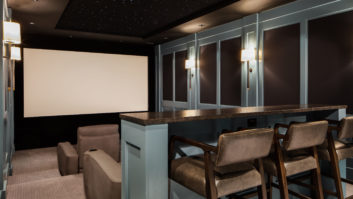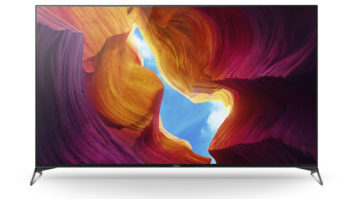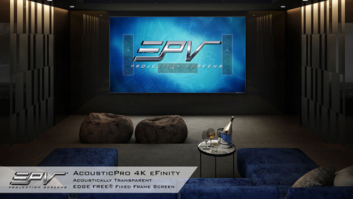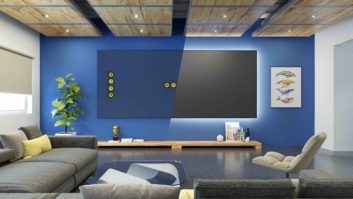
The Draper Onyx ambient light-rejecting screen provides higher clarity than a traditional matte white display in settings with ambient light.In the “good old days,” when a projection screen was being installed in a home it was mostly for a dedicated theater room. After all, it was called “home theater!” In those situations, viewing surface choice was fairly simple, because ambient light was controlled and the screen was almost always being used in the dark. Put up a 1.0-gain matte white surface and you were ready to go.
But over the years the concept of home entertainment has advanced. Sure, there are still plenty of dedicated home theaters, but now people also want to use their screens for more. If you’re throwing a super bowl party, for instance, you want the lights on. In addition, there may not be room for a dedicated home theater, so the screen is going in a multiple use space, which, again, means more ambient light.
Because people have been using 1.0 gain white projection screens for so long, we still see them in use—even in those multi-purpose rooms with ambient light—and a room with uncontrolled light is definitely not where you want a white screen. They’re very diffusive and spread light in a very wide pattern, and they do this with both projection light and room ambient light. That means both types of light are competing for the viewer’s eyes, so the image on the screen looks “washed out” when the light is not controlled.
There are other options available to the homeowner. One option is to use a high-gain white screen. Using a higher gain white screen will improve the brightness of the image, but there are two major drawbacks to consider: contrast can suffer, and the seating arrangement to view the screen should be as close to on-axis as possible. Even high-gain screens are best used when the ambient light can be controlled.
That’s why if ambient light is an issue in your room, you should be looking at an ambient light-rejecting screen.
The usual assumption, when dealing with uncontrolled ambient light in a multi-purpose area, is to handle it with a gray screen. However, simply “going gray” isn’t necessarily the right answer. Not all gray screens are ambient light-rejecting. While their black tints allow some of them to improve contrast, they are still mostly diffusive surfaces and don’t “reject” or “reflect” off-axis ambient light away from the audience. Traditional gray screens also tend to have very low gains. That means that they will eat up your projected light, again forcing you into a brighter projector.
That’s why the best choice for a room with a good amount of ambient light is an actual ambient light-rejecting material. The best ones are typically darker grey, which helps with image contrast, but they are more angular reflective than diffusive. Reflective components in the vinyl surface reflect off-axis ambient light away at the same angle as it is hitting the surface, essentially bouncing it away from the audience.
There is a caveat here. You can take it too far. Materials that are the most ambient light-rejecting are so reflective that you can sometimes see hot spotting. They also typically have narrow viewing cones. The best choice is an ambient light-rejecting material with a good balance of angular reflectance and diffusion.
A quick word about color: remember that gray tints reduce gain in most ambient light-rejecting materials, and tend to “muddy” bright colors. This requires a brighter projector to sufficiently “light up” those colors, or better ambient light control. Even with that, however, ambient light-rejecting materials provide the best solution in lighted rooms, especially when proper selection tools are used to find the right material.
Not all ambient light-rejecting screens are the same. Go for one that gives you the best of all the characteristics needed for good design: the right gray tint for contrast, the right gain for brightness and wide viewing angles, Imaging Science Foundation-certified for true color reproduction, and 4K ready. Don’t settle!
Besides habit, cost is another reason we still see matte white screens being used instead of ambient light-rejecting materials. Ambient light-rejecting surfaces have traditionally come with a higher price tag, so the cheaper matte white screens get used with a brighter projector. This doesn’t really solve the problem. Throwing more brightness at a white screen doesn’t enhance the contrast, and no projector can compete with good ole’ sunlight! Today there are more ambient light-rejecting surfaces on the market, which means less expensive options have become available. You don’t have to settle.
So how do you know which material to use in your situation? There are a couple of questions you need to ask. Assuming you know the screen type and size, you also need to know ambient light levels and the widest off-center seating angle in the room.
At Draper we use an online calculator called the “Projection Planner” to calculate system brightness and contrast. Without a tool like this, you are guessing at image quality. To use Draper’s Projection Planner you must register, but it is free.
Amy Madden (MBA, CTS, LEED AP) is the residential market manager at Draper, Inc.





